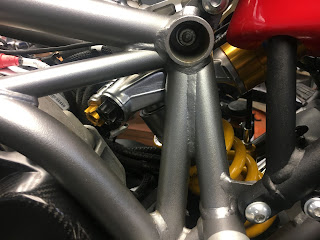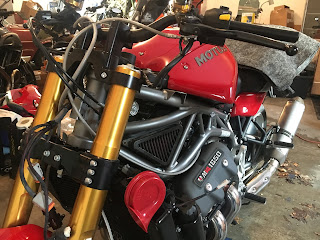The Motus gearing is quite tall. The low engine redline in combination with a desired top speed has the stock gearing too tall for around town. The goal for this bike was to take the gearing down to a more 'around town' level.
The original chain had one link ground off to take the transmission off. Normally you would pull the counter shaft sprocket to remove the swing arm, but I was changing the gearing anyway. The stock chain was not long enough to work with the larger rear sprocket.
The stock gearing is a 41 tooth rear. I updated to a 43 tooth rear which will give the bike better manners around town, but will also run at a higher RPM at highway speed.
The front sprocket is 16 tooth from the factory. There is not much clearance to change this sprocket size and was left alone.
The software for Motus requires a cable that can talk CAN bus. This is a standard for automotive and other applications.
The cable is made by Ecom and can be purchased HERE
The cable that is supplied needs to have a 3 pin Deutsch connector installed.

The wiring from the Ecom adapter to Deutsch connector is below. I have a Deutsch terminal set which makes this easy. The two extra wires that are included with the Ecom cable were taped off and left alone.
A chain and sprocket ratio calculator is used to calculate the speedometer error HERE.
Standard gearing is a 2.563: 1 ratio
Modified gearing is a 2.688:1 ratio
The speedometer will need to be modified by 4.877%
The speedo is a magnetic pickup off of a gear within the transmission. The pickup creates a frequency that is converted to a speed. The software setting in the speedometer calibration screen is 39500 that was increased by 4.877% to 41426 as this shaft will be turning faster to maintain equivalent speed.
 A GPS is used to verify the speedometer. It is spot on across all speeds from 5mph-80mph. Motus would use a dynamometer and set the cruise control for this task, but a GPS was an adequate tool.
A GPS is used to verify the speedometer. It is spot on across all speeds from 5mph-80mph. Motus would use a dynamometer and set the cruise control for this task, but a GPS was an adequate tool.
The gearing is ideal for the use of this bike. Not too tall for around town, not too low for highway speeds. There might even be room for one more tooth in the rear (44), but I am happy with this arrangement.
















































